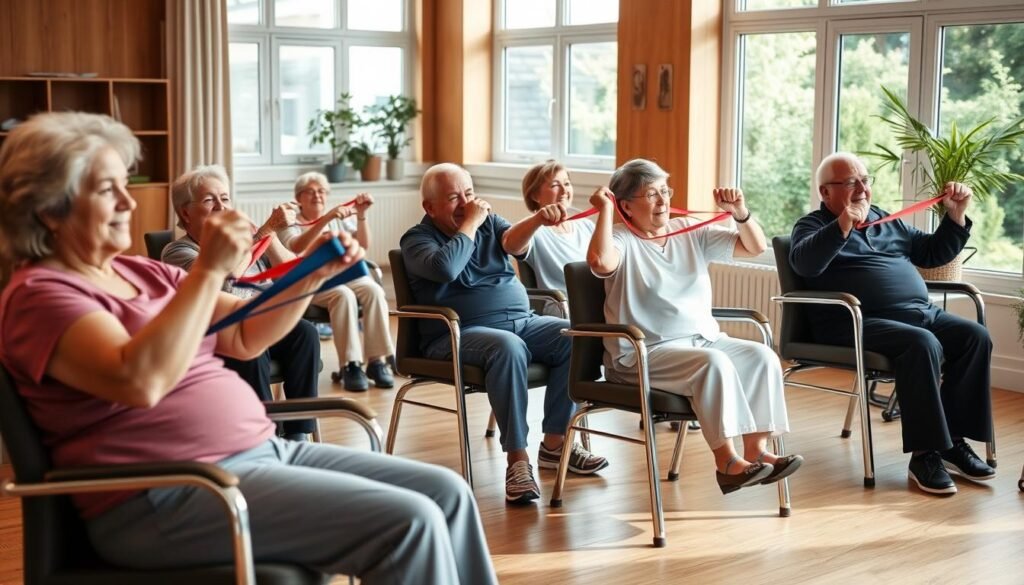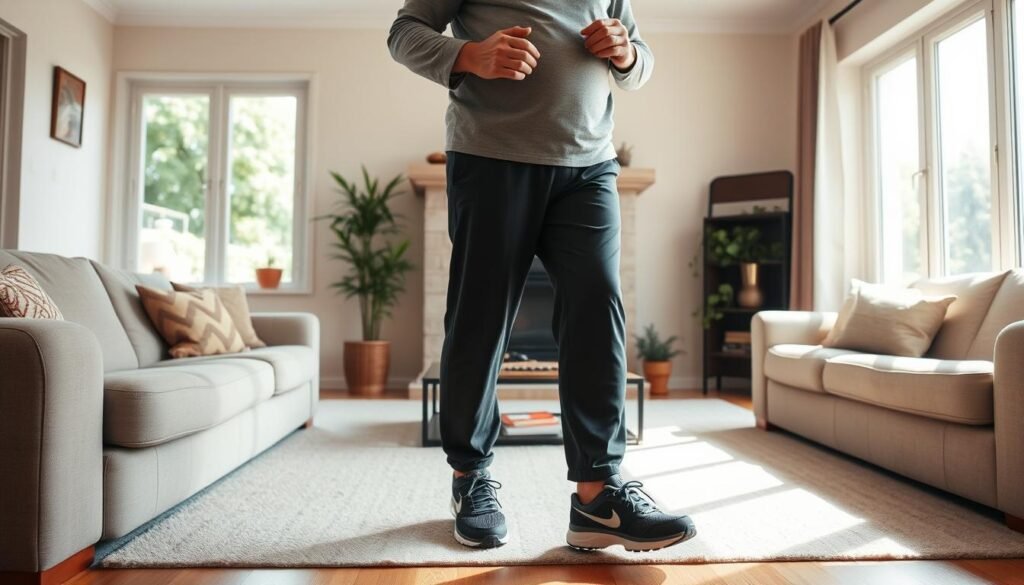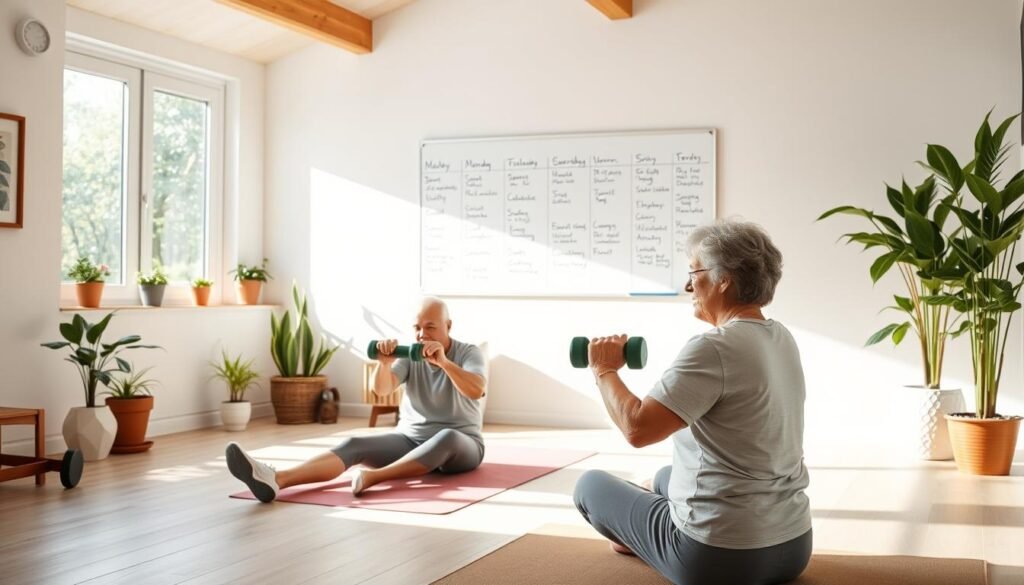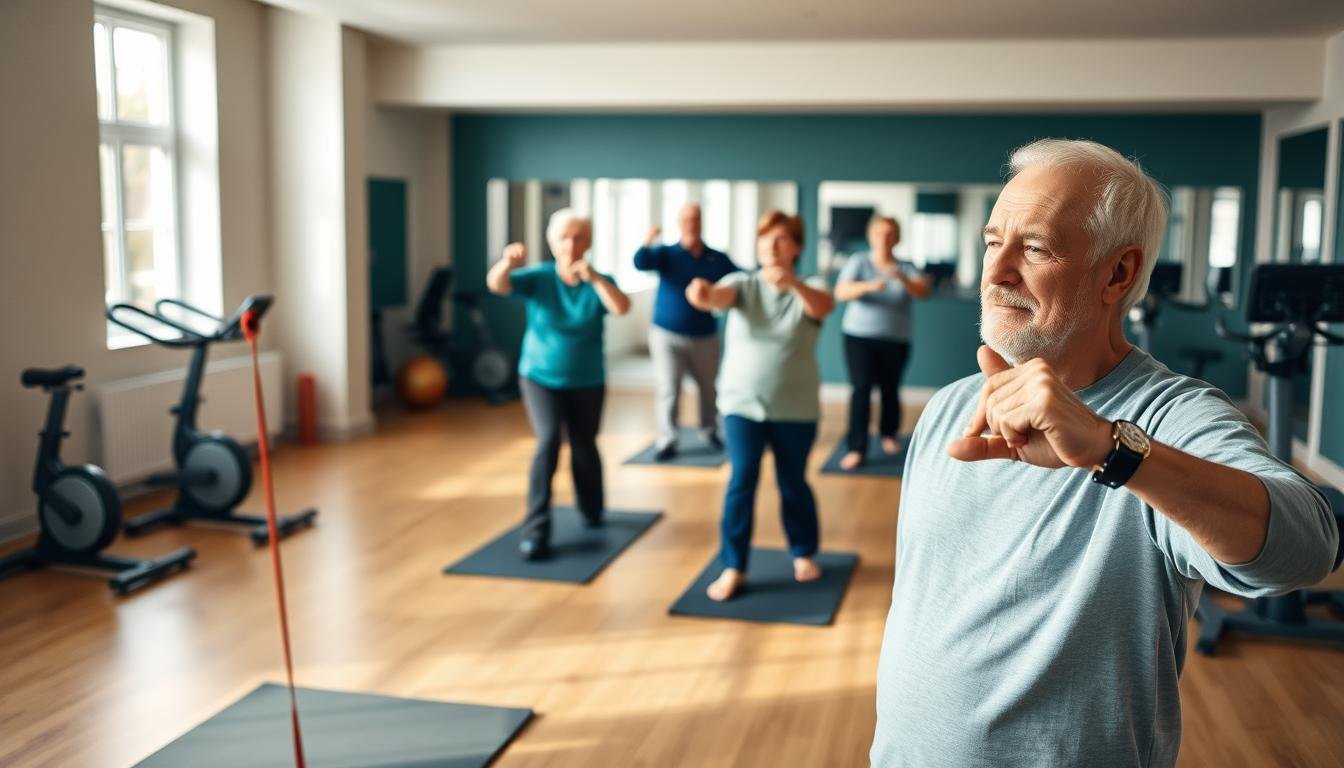If you’re living with diabetes, you might wonder if exercise helps. The answer is a big yes!
Regular physical activity is great for older adults with diabetes. It can make you feel better and healthier.
When you start looking into fitness routines, you’ll find many exercises just for you. These are safe, fun, and help you manage your diabetes well.
Key Takeaways
- Regular exercise is beneficial for seniors with diabetes.
- Physical activity improves overall health and well-being.
- Tailored fitness routines can be safe and enjoyable.
- Exercise helps manage diabetes effectively.
- Various workout options are available for older adults.
Why Exercise Matters When You Have Diabetes
As a senior with diabetes, regular exercise is very helpful. It’s key to managing your diabetes and keeping you healthy.
Exercise makes your body use insulin better. This hormone helps turn blood sugar into energy. Being active helps control blood sugar, keeps blood pressure healthy, and boosts your overall well-being.
The Science Behind Exercise and Blood Sugar Control
When you exercise, your body uses glucose for energy. This lowers your blood sugar. Regular activity also makes your body better at using insulin. This helps control blood sugar and lowers the risk of diabetes problems.
Key benefits of exercise for blood sugar control include:
- Improved insulin sensitivity
- Lower blood sugar levels
- Reduced risk of diabetes-related complications
Additional Health Benefits for Seniors with Diabetes
Exercise also brings many other health benefits for seniors with diabetes. These include:
- Improved cardiovascular health
- Enhanced balance and flexibility
- Better mental health and reduced stress
- Weight management
Adding physical activity to your daily life can bring these benefits. It can also make your life better overall.
Before You Start: Safety Precautions
Before starting any exercise, seniors with diabetes need to think about safety first. It’s important to plan carefully to avoid problems.
Consulting your healthcare provider is the first step. They can give advice that fits your health and meds.
Getting Medical Clearance from Your Doctor
Getting a doctor’s okay is key before starting new exercises. Your doctor will check your health and suggest the best exercises for you.
Monitoring Blood Sugar Before, During, and After Exercise
Checking your blood sugar is very important when you exercise with diabetes. Always check your blood sugar before, during, and after exercise. This helps keep your sugar levels safe.
Warning Signs to Stop Your Workout
Know the signs to stop exercising right away. These include dizziness, chest pain, or feeling very short of breath. Listening to your body is important for safe exercise.
As the American Diabetes Association says, ”
people with diabetes should be aware of the warning signs of both low blood sugar and high blood sugar and know how to respond
.” Knowing these signs is key for safe exercise.
Essential Diabetes Exercises for Seniors
Managing diabetes is easier with the right exercises. These activities help control blood sugar and keep your heart healthy. For seniors, it’s best to pick low-impact exercises that are easy on your body.
Walking, strength training, and balance exercises are great for seniors with diabetes. They help manage diabetes and prevent falls. Plus, they make moving around easier.
Walking: The Perfect Starting Point
Walking is easy and can be done almost anywhere. It’s great for getting your blood flowing and heart beating. You can walk in your neighborhood or on a treadmill at home.
For more ideas on low-impact exercises, visit https://healthylifestyleforseniors.com/low-impact-exercises-for-seniors/.
Gentle Strength Training with Resistance Bands
Gentle strength training with resistance bands is a good choice. These bands are light, easy to carry, and simple to use. They help make your muscles stronger, which is important for moving around.
Balance Exercises to Prevent Falls
Balance exercises are key for seniors with diabetes. Standing on one foot or walking in a straight line can improve balance. Doing these exercises often can make you feel steadier and more confident.
Chair Exercises for Limited Mobility
Seniors with diabetes can stay active with chair exercises. These are low-impact, perfect for those who move less. Doing chair exercises can help your health, flexibility, and diabetes control.

Seated Arm and Shoulder Workouts
Start with seated arm and shoulder workouts. They keep or boost your arm and shoulder strength. Try arm raises, shoulder rolls, and seated marches. They’re easy and need little gear, great for seniors.
Lower Body Strengthening While Seated
Lower body strengthening is doable while sitting. Try seated leg lifts, toe taps, and ankle rotations. These boost leg muscle and blood flow without hurting your joints.
Chair Yoga for Flexibility and Stress Reduction
Chair yoga is great for seniors with diabetes. It mixes gentle stretches with deep breathing. This improves flexibility and lowers stress, fitting all fitness levels.
Adding these chair exercises to your day can help manage diabetes and boost your health.
Water-Based Workouts for Joint Protection
Water-based exercises are great for seniors with diabetes. They are gentle and keep you fit without hurting your joints. Swimming and other water activities are low-impact. This means they lower the chance of injury and joint pain.
The American Diabetes Association says water exercises help manage blood sugar. Water walking and aqua aerobics are good to start with. They are easy and can be changed to fit your fitness level.
Water Walking and Aqua Aerobics
Water walking lets you walk in the pool at different speeds. Aqua aerobics mixes dance and aerobics in the water. Both are fun and good for your heart without hurting your joints.
Swimming Routines for Cardiovascular Health
Swimming works many muscles at once. It’s great for your heart, burning calories, and improving fitness. You can adjust swimming routines to fit your fitness level, making it good for seniors with diabetes.
Pool Exercises for Strength and Balance
Pool exercises like water jogging and leg lifts boost strength and balance. They are good for seniors because they lower the risk of falls and injuries. The water’s buoyancy offers natural resistance, strengthening muscles safely.
Low-Impact Cardio Options
Seniors with diabetes can safely boost their heart health with low-impact cardio. These exercises are gentle on the body and fit any fitness level. Doing them regularly can make you feel more energetic and better overall.

Stationary Cycling for Seniors
Stationary cycling is great for seniors with diabetes. It’s easy on the joints and can be done at your own pace. You can change the resistance to fit your fitness level.
It’s perfect for those who need a low-impact activity. Cycling regularly can also make your heart healthier and your legs stronger.
Elliptical Training Basics
Elliptical training is another good option. It’s like running but easier on your joints. It works your whole body, giving you a great cardio workout.
You can start with low resistance and get stronger over time. For more info on cardio, check out this guide for older adults.
Dancing: Fun Cardio That Doesn’t Feel Like Exercise
Dancing is a fun way to get your cardio in. It’s easy to do and can be adjusted to fit your fitness level. Dancing works many muscles, improves heart health, and boosts balance.
You can take a dance class for seniors or dance at home to your favorite tunes.
Strength Training for Better Blood Sugar Control
For seniors with diabetes, strength training is very helpful. It improves health and how well the body uses insulin. As we get older, we lose muscle, making it harder to control blood sugar. Resistance exercises and weight training build lean muscle, which helps keep blood sugar stable.
Adding strength training to your diabetes plan helps your body use insulin better. This is key for managing blood sugar levels.
Bodyweight Exercises for Beginners
You don’t need special gear to start strength training. Bodyweight exercises are perfect for beginners. Try squats, lunges, and wall push-ups.
These exercises work many muscles at once. You can adjust them to fit your fitness level. For example, chair squats are easier than regular squats.
Light Dumbbell Workouts for Muscle Building
When you’re ready, try light dumbbells. They’re great for many exercises that target different muscles. For seniors with diabetes, exercises for the upper body, lower body, and core are best.
Start with light weights and slowly add more as you get stronger. This helps build muscle and strength.
How Strength Training Improves Insulin Sensitivity
Strength training makes your body better at using insulin. It builds muscle, which helps with glucose metabolism.
Regular exercise, including strength training, improves how your body handles glucose. This helps keep blood sugar levels in check, reducing diabetes risks.
Flexibility and Balance Routines
Flexibility and balance exercises are key for seniors with diabetes. They boost your physical skills and help your body manage blood sugar. They also lower the chance of falls.
Simple Stretching Exercises for Daily Practice
Adding simple stretches to your day can boost flexibility. Start with neck stretches, shoulder rolls, and calf raises. These are easy and can be done sitting or standing.
Tai Chi for Balance and Mindfulness
Tai Chi is an old martial art turned into a low-impact exercise. It helps with balance and lowers stress. It connects your mind and body, making falls less likely. Many places offer Tai Chi classes for seniors.
Yoga Poses Modified for Seniors
Yoga is great for seniors with diabetes, combining poses, breathing, and meditation. Many poses can be changed for seniors. Chair yoga is a good example, done while seated, improving flexibility and balance.

Group Exercise Options for Social Support
Group exercise programs are great for seniors with diabetes. They offer a supportive place to work out. This can help keep seniors motivated and feeling part of a community.
These groups do more than just help with fitness. They also offer emotional support and a chance to meet new people. This is key for feeling good overall.
Senior Fitness Classes at Community Centers
Local community centers have special classes for seniors. These classes mix cardio, strength, and flexibility exercises. Senior fitness classes are led by experts who know what seniors need.
The American Diabetes Association says people with diabetes should exercise a lot. Senior fitness classes help meet this goal. Plus, they offer a friendly place to be active.
Finding Diabetes-Specific Exercise Programs
Seniors with diabetes can really benefit from special exercise programs. These programs are made just for them. They teach how to manage blood sugar and improve insulin use.
To find these programs, talk to your doctor or local diabetes groups. You can also look online for classes in your area. Joining these programs can make managing diabetes easier.
Creating Your Weekly Diabetes Exercise Plan
Creating a weekly exercise plan for diabetes can feel hard. But, breaking it down into smaller goals makes it easier. Aim for 150 minutes of moderate exercise each week, as the American Diabetes Association suggests. This can be split into smaller sessions, like 30 minutes, five days a week.

Sample Schedules for Different Fitness Levels
Your plan should fit your fitness level and goals. Beginners should start with short sessions (20-30 minutes). Then, they can increase the time and intensity. More advanced folks might do longer or more intense workouts.
- Beginners: 10-15 minute walks, 3 times a day
- Intermediate: 30 minutes of brisk walking or swimming, 5 times a week
- Advanced: 50-60 minutes of cycling or aerobics, 3-4 times a week
The American Council on Exercise says mixing up your exercises keeps things interesting. This helps you stay on track with your workouts.
Tracking Your Progress and Blood Sugar Response
It’s important to track your progress to see how exercise affects your blood sugar. Log your workouts, including the type, how long, and how hard. Also, note your blood glucose levels before and after exercising. This helps you see patterns and adjust your plan as needed.
Tracking your progress helps manage diabetes and keeps you motivated. Seeing the good effects of your hard work on your health is rewarding.
Overcoming Common Exercise Challenges
When you exercise with diabetes, you need to get ready for challenges. Exercise is key to managing diabetes, but it comes with hurdles. These can include staying motivated and dealing with complications.
Staying Motivated When Progress Seems Slow
It’s hard to stay motivated when you don’t see results fast. Setting small, achievable goals can help. Start by walking your dog a little further each day. Celebrate these small wins to stay motivated.
Exercising Safely with Diabetic Complications
Diabetic complications can change how you exercise. Monitoring your blood sugar levels before, during, and after is key. Pay attention to how your body reacts and adjust your workout. If you feel weird, stop and talk to your doctor.
Adapting Workouts for Changing Health Needs
Your workout needs to change as your health does. Regularly check your fitness level and adjust your routine. If walking is too hard, try chair exercises or water workouts. Being flexible is important for a safe and good workout.
“The greatest wealth is health.” – Virgil
Conclusion
You’ve learned about many diabetes exercises for seniors. These can make you healthier and happier. Regular exercise helps control blood sugar and lowers the risk of problems.
When you start these exercises, you’ll see big changes. Your body will get better at using insulin. You’ll also feel your heart and mind getting stronger.
It’s key to start slow and keep going. Don’t push too hard at first. But as you get better, you can do more.
For diabetic seniors, staying motivated is important. You can find lots of help, like the NCOA’s Diabetes for Older Adults library. It has lots of useful info and tips.
Exercise should be a part of your daily life. It makes you feel great and keeps you healthy. The more you do it, the easier it gets, and you’ll feel even better.
FAQ
What are the best exercises for seniors with diabetes?
Good exercises for seniors with diabetes include walking and using resistance bands. They should also do balance exercises, chair exercises, and water workouts. Low-impact cardio like cycling and dancing is also good.
How often should seniors with diabetes exercise?
Seniors with diabetes should exercise for 150 minutes a week. They should mix aerobic, strength, and flexibility exercises. Always talk to a doctor to make a plan that’s right for them.
Are there any exercises that seniors with diabetes should avoid?
Seniors with diabetes should not do high-impact exercises that hurt their joints. They should also avoid heavy lifting and bending. Always check with a doctor before starting a new exercise.
How can seniors with diabetes monitor their blood sugar levels while exercising?
Seniors with diabetes should check their blood sugar before, during, and after working out. They should know the signs of low blood sugar, like feeling dizzy or shaky.
Can seniors with diabetes exercise in a group setting?
Yes, seniors with diabetes can work out in groups. This can be fun and help them stay motivated, like in senior fitness classes.
What are some tips for staying motivated to exercise with diabetes?
To stay motivated, set goals and track your progress. Find a workout buddy and change your routine to keep things interesting.
How can seniors with diabetes adapt their exercise routine to changing health needs?
Seniors with diabetes should talk to their doctor to adjust their workout plan as needed. This includes changes in health or new medications. Listen to your body and stop if you need to.
Are there any senior-friendly diabetes exercise programs available?
Yes, there are many programs for seniors with diabetes. These include chair yoga, water workouts, and low-impact cardio classes. These can be changed to fit what seniors can do.
Can strength training help improve insulin sensitivity in seniors with diabetes?
Yes, strength training can help seniors with diabetes use insulin better. It builds muscle, which helps with insulin use. Use light weights and do lots of reps.

